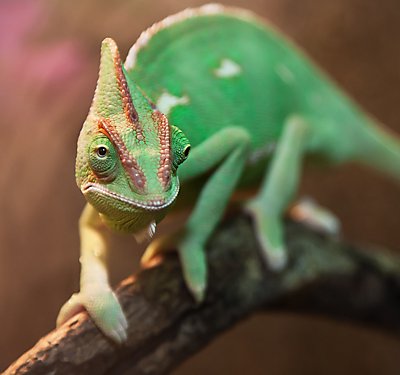
 top
top
REPTILE / health & care
Supplies You’ll Need for Your Reptile Terrarium Setup
Overview
Are you bringing home a new pet reptile? Then you want to make sure you have all of the reptile supplies you’ll need to create an ideal home for them. Whether you’re bringing home a bearded dragon, a leopard gecko or a box turtle, they all need something a little different in their habitat that makes it special for them.
Things Most Pet Reptiles Need:
- Terrarium/Aquarium/Habitat - Every pet reptile needs an enclosure to keep them safe and happy. Terrariums are used to create the perfect habitat for your reptile so that they can thrive in their environment. After all, your house does not look like the natural habitats those pets are used to.
- Heating - Most reptiles need their environment to be a certain temperature. Heating lamps and water heaters are used to keep their habitat warm, even if it’s cold.
- Lighting - Most pet reptiles need their habitat to mimic the natural day and night cycles of the outdoors. UVA/UVB bulbs with timers can be used for this purpose.
- Thermometer - Thermometers help you monitor the temperature of your pet’s home to make sure it’s perfect for their needs.
- Hygrometer - Humidity is an important factor of any reptile's environment. Some need more humidity, and others need less. A hygrometer helps you measure the humidity levels in their tank.
- Substrate - Substrate is what lines the bottom of their home so that they have something safe to walk on, dig in and use the restroom. It has to be cleaned and replaced regularly to stay in tip-top shape.
- Disinfectant & Deodorizers - Speaking of cleaning, every reptile habitat needs reptile-safe disinfectants and deodorizers to keep everything fresh.
- Artificial Reptile Plants - There are real plants that are safe to keep in your reptile habitat, but artificial reptile plants are much easier to take care of.
- Food/Water Dishes - Most reptiles, especially ones with substrate in their habitat,, need reptile food dishes so they don’t accidentally eat their substrate. Reptile water dishes can also help maintain a habitat’s humidity.
- Reptile Habitat Décor - Make sure to place plenty of reptile habitat decor that is designed for your specific pet. Some like logs, some like leaves, branches or even ramps.
If you’re looking for something with all the essentials, try a reptile starter kit.
Differences for Specific Pet Reptile Habitats:
Aquatic Turtles -
- Aquarium - An aquatic turtle’s aquarium should be 10 gallons (40 liters) for every 1 inch (2.54cm) of turtle shell. That means if you have a 5-inch (12.7cm) turtle, you need a 50-gallon (190 liter) aquarium.
- Water - Use dechlorinated water, making sure to change 50% of it once a week and 100% of it once a month. Make sure to never use water from the sink that has been softened.
- Basking/Dry Spot - There should be a space at the top for them to come up to dry land. This top area should be a temperature gradient, meaning there should be a cool side and a warm side (where they can bask).
- Temperature - Their dry spot temperature should be 75-85° F (24-29°C) on the cool side and 90-95° (32- 35°C) on the warm side/basking spot. The water temperature should stay around 72-77° F (22-25°C) and the nighttime temperature should be 65-75°F (18-24°C).
- Aquarium Filter - Because aquatic turtles live in water, you’ll need an aquarium filter/filter media to keep their water clean and fresh.
Tortoises -
- Terrarium - 50-gallon (190 liter) terrarium or larger with a screened lid.
- Substrate- Use reptile-safe substrate, making sure to clean it out regularly.
- Temperature - Create a temperature gradient using a heat lamp and UVB bulb for them to bask under. Their temperatures should range from 72-80°F (22-27°C) on the cool side and 90-95°F (32-35°C) on the warm side. At night, their temperature should be between 70-80°F (21-27°C).
- Humidity - Greek And Hermann’s tortoises need humidity to stay around 40-60.% and Russian tortoises need it between 30-50%.
Bearded Dragons -
- Terrarium - 10-20 gallon (40 liter) terrarium or larger with a screened lid.
- Substrate - Reptile carpet or tile is best; remove droppings as needed and clean every week.
- Temperature - Create a temperature gradient using a heat lamp and UVB bulb for them to bask under. Their temperatures should range from 75-85°F (24-29°C) on the cool side and 95-100°F (35-38°C) on the warm side. At night, their temperature should be between 65-75°F (18-24°C).
- Humidity - Their humidity should stay between 20-30%.
Corn Snakes -
- Terrarium - a 20-gallon (75 liter) terrarium, or one that is 2/3 their length with a screened lid.
- Substrate - Line the bottom of their habitat with reptile carpet or reptile bedding. Make sure to remove droppings frequently, stirring every other week and changing monthly.
- Temperature - Create a temperature gradient using a heat lamp and UVB bulb for them to bask under. Their temperatures should range from 70-75°F (21-24°C) on the cool side and 80-85°F (27-29°C) on the warm side. At night, their temperature should be between 65-70°F (18-21°C).
- Humidity - Their humidity should stay between 30-50%.
Leopard Geckos -
- Terrarium - 20-gallon (75 liters) tank or larger with a screened lid.
- Substrate - Use reptile carpet or tile. Make sure to remove droppings at least once a week and thoroughly clean it once every other week.
- Temperature - Create a temperature gradient using a heat lamp and UVB bulb for them to bask under. Their temperatures should range from 75-90°F (24-32°C) on the cool side and 85-95°F (29-35°C) on the warm side. At night, their temperature should be between 65-75°F (18-24°C).
- Humidity - Their humidity should be kept between 10-30%.
Information in this article is not intended to diagnose, treat or cure your pet and is not a substitute for veterinary care provided by a licensed veterinarian. For any medical or health-related advice concerning the care and treatment of your pet, contact your veterinarian.
Pet Safety Tips:
ALL ANIMALS can potentially carry viral, bacterial, fungal, and parasitic diseases contagious to humans.
Thoroughly wash your hands with warm, soapy water before and after contact with any pet or its habitat.
Adults should assist children with hand washing after contact with a pet, its habitat or aquarium water.


























